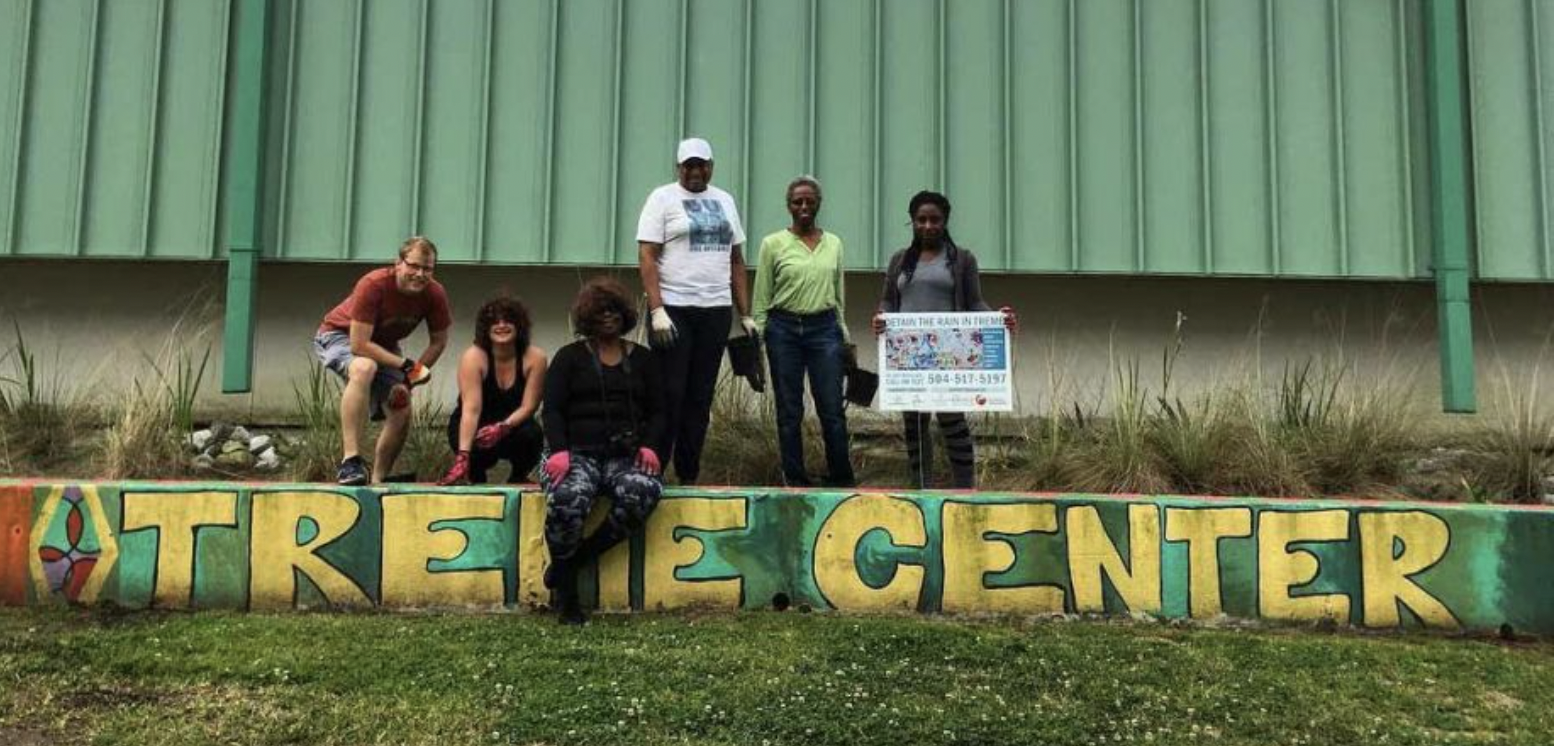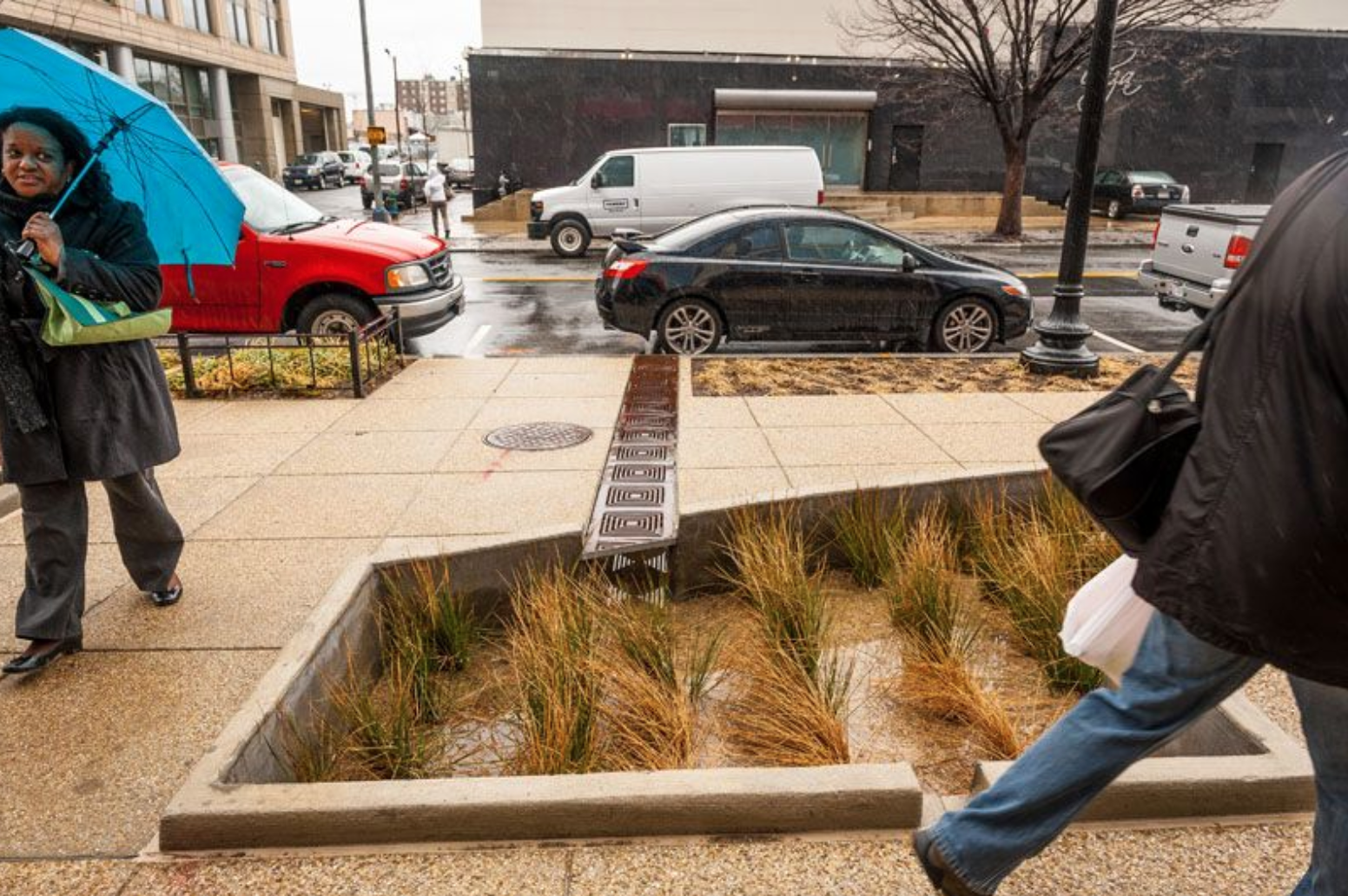People Power Stopping Flooding in New Orleans
People Power Stopping Flooding in New Orleans
By Emily Nonko, Next City, November 22, 2021
Photos usable. word count: 977
Special rules: Please include the tracking pixel into the source or HTML view of your CMS when republishing this story. The tracking pixel can be found at the bottom of the story.
This fall, at the intersection of Saint Bernard Avenue and North Claiborne in New Orleans’ 7th Ward, construction began on a new stormwater drainage system. This wasn’t a “gray infrastructure” project planned by the city. It’s green infrastructure that 7th Ward community members had envisioned, a large bioswale with native plants that will absorb the water that frequently floods the neighborhood.
This is one of three large-scale, anti-flooding developments underway in the 7th and Upper 9th Wards as well as Tremé. All are community-driven green infrastructure facilitated by Water Wise Gulf South, an environmental outreach collaborative prioritizing the needs of New Orleans residents who have been, and continue to be, most impacted by regular urban flooding caused by heavy rainfall. Since 2016, Water Wise has supported planting of over 500 trees and implementation of over 150 other green infrastructure projects that have added over 50,000 gallons of stormwater retention capacity across the three neighborhoods. What makes Water Wise different from other green nonprofits? All of its projects are actually designed and built by local community members.
“We are making sure that those of us who are disproportionately affected, Black and brown communities, have the opportunity to take charge and lead our destiny in mitigation,” says Angela Chalk, a 7th Ward resident who founded the organization Healthy Community Services and has been the key point of contact for Water Wise activities in her neighborhood. “We live and work in the communities that we serve.”
Water Wise Gulf South was founded by the water professionals Jeff Supak, Hilairie Schackai and Dana Brown to strengthen public awareness and use of green infrastructure across the region. (Green infrastructure encompasses a variety of nature-based installations that capture rain where it falls to mitigate flooding. Gray infrastructure relies on drains, concrete and pipes to collect and channel stormwater into waterways without reducing the amount of water, so it often exacerbates flooding.)
Water Wise knew that localized urban flooding — not captured in FEMA’s flood risk maps — had become a persistent problem in many communities. In 2014 and 2015, they conducted flood mapping surveys across New Orleans and identified the neighborhoods most at risk.
After identifying the 7th Ward and Tremé, Water Wise partnered with the Greater Treme Consortium and Chalk’s Healthy Community Services to brainstorm around green infrastructure. “There was a lot of feedback around actually demonstrating green infrastructure in the community,” says Supak. Since 2016, grants have helped Water Wise develop the “Water Wise Neighborhood Champions” program that would not only provide education to community leaders, but help communities identify priority projects for installation.
In the three-pronged program, participants begin with a Water Wise Neighborhood Workshop to learn about green infrastructure and do-it-yourself green infrastructure projects that people can install in their own yards or gardens. Over 500 people have taken one of these workshops. That’s followed by a Green Infrastructure Tour, where participants visit green infrastructure projects across New Orleans (it went virtual during COVID-19). Finally, Water Wise holds Green Infrastructure “Visioning Workshops” to identify priority projects within neighborhoods.
135 people have completed the full program. Community members in Tremé, the 7th Ward and Upper 9th Ward all developed community look-books that propose projects that could collectively store 6.5 million gallons of water and increase green space by 45 acres.
Following the program, Water Wise holds pitching challenges to provide seed funding for implementation of projects in the look-book. Brenda Lomax-Brown, the president of the Hollygrove Dixon Neighborhood Association, proposed green infrastructure for the Hollygrove-Dixon Life Transformation Community Center, where rain would pool at the entrance stairs and community members needed rain boots to get inside. With Water Wise funding the community installed a permeable parking pad and rain garden. “When the first rain came, to see the water get sucked up and no more water pooling at the stairs — it was just an awesome experience,” Lomax-Brown says.
Installation has been key to bringing more community members into the work. “Inside the community I live in, people might not catch on at first — but once they see it, it becomes infectious and everyone wants to understand it,” says Katherine Prevost, president of the Bunny Friend Neighborhood Association in the Upper 9th Ward.
In the 7th Ward, 100 community members helped install the community’s first bioswale. “Finally the rain came and I had this ah-hah moment that this works and that we can begin to do this along with everyone else in the neighborhood,” says Chalk.
Since then, Water Wise 7th Ward has held or participated in 37 community outreach, education and social events that engaged over 800 people around green infrastructure. In addition to the bioswale, the community installed 25 rain barrels, one stormwater planter box, seven rain gardens, eight french drains and two permeable parking pads. They’ve planted over 400 trees and removed 250 square feet of concrete.
The 7th Ward projects are managing 48,000 gallons of stormwater for each rainstorm event, a number that includes the 35,000 gallons that will be managed with the newest stormwater drainage system.
Beyond Water Wise seed funding, the community organizations independently work to fund projects from their look-books. “This is a grassroots movement, in my opinion, we’re doing everything without government help or funding,” says Supak. “Government is slow and we can’t wait for government to catch up to us,” Chalk says. “All of us in these communities realize we have to get this right and that climate change is not waiting. We can’t wait.”
Water Wise community leaders hope not just to normalize green infrastructure, but pave the way for a Black-led environmental justice movement prioritizing the needs of communities hit hardest by climate change. “When history is written,” Chalk says, “There will be Black and Brown faces all over the beginnings of the green infrastructure sector, at least in New Orleans and Southeast Louisiana.”
Tracking pixel:
https://www.google-analytics.com/collect?v=1&t=pageview&tid=UA-2562581-1&cid=f6978269-2853-4e7f-8159-2cbac2077bec&dh=nextcity.org&dt=%5BSJN%5DPeople%20Power%20Stopping%20Flooding%20in%20New%20Orleans&dp=sjn/https://nextcity.org/urbanist-news/entry/people-power-stopping-flooding-in-new-orleans






